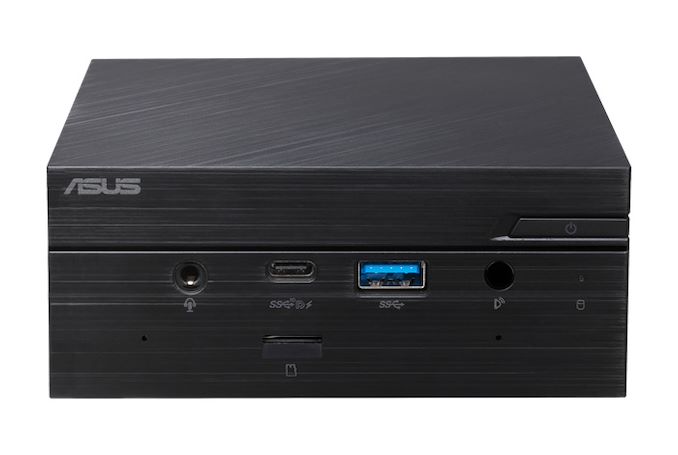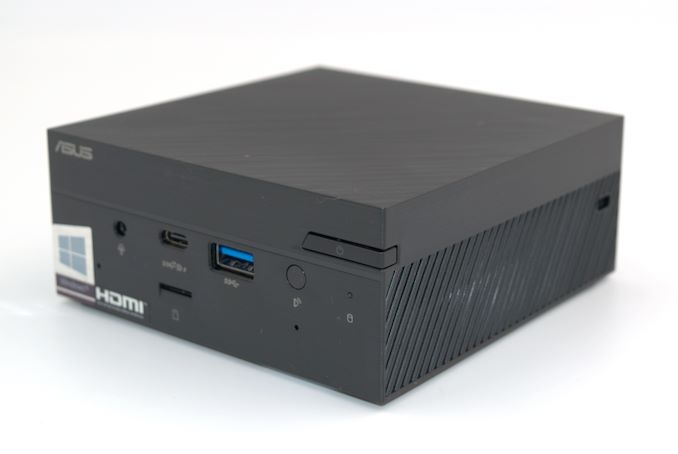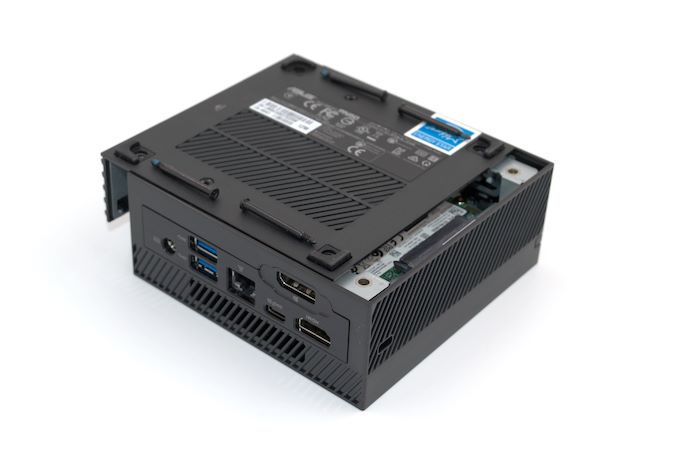ASUS PN50 mini-PC Review: A Zen 2 Business NUC
by Ganesh T S on October 1, 2021 10:00 AM EST- Posted in
- Systems
- AMD
- Asus
- NUC
- UCFF
- Mini-PC
- Zen 2
- Ryzen Embedded
- Renoir
- Ryzen 4000
- Ryzen 7 4800U

Ultra-compact form-factor (UCFF) machines have been one of the major drivers in the resurgence of the PC market. The trend was kickstarted by Intel's NUCs in the early 2010s. These PCs have usually relied on low-power processors with compelling performance per watt metrics. AMD was largely absent in this market till the introduction of the Ryzen processors. While ASRock Industrial was one of the first to release a UCFF mini-PC based on the first-generation Ryzen embedded processors, multiple OEMs have lined up to utilize the second-generation AMD processors in their own high-performance mini-PC lineups.
The PN series represents the range of UCFF PCs from ASUS. The ASUS PN30 (a fanless PC based on Carrizo-L) was introduced in early 2020 as AMD's sole representation in the PN series. This was followed up in Q3 2020 by the ASUS PN50, and more recently, the PN51. While the PN30 was a low-end offering, the ASUS PN50 (which we are looking at today) makes a play for the high-end market by using the Renoir APUs in the Ryzen 4000 mobile series. The focus of the PN series in general, and the PN50 in particular, is more on small and medium-businesses rather than the home consumer base.
This is not our first look at the Renoir APUs in the NUC form-factor. We had reviewed another Ryzen 7 4800U offering in the ASRock Industrial 4X4 BOX-4800U late last year. Since then, Intel's Tiger Lake-based UCFF PCs have been introduced into the market. The electronics industry supply chain is continuing to face challenges, requiring business consumers to line up and qualify multiple options for deployment. This review provides a comprehensive evaluation of the performance and value proposition of the ASUS PN50 in this context.
Introduction and Product Impressions
Small form factor PCs have become one of the top choices for installation in business environments. Thanks to continued improvements in processor computing power as well as power efficiency, scenarios that require traditional tower desktops have shrunk considerably. UCFF systems fulfilling business requirements such as remote management and ease of deployment have become widely deployed in SMBs and SMEs. Intel's vPro offerings have been the mainstay in this market segment, with AMD's adoption of DASH for out-of-band client management enjoying comparatively limited success.
After the introduction of Zen 2-based APUs, there has been renewed interest in SMB / SME UCFF PCs based on AMD's processors. Thanks to TSMC's 7nm process and AMD's revamped microarchitecture, the Renoir APUs based on Zen 2 were able to offer stiff competition to Intel's flagship processors. In addition to retaining the multi-core leadership, the improvements enabled Renoir to to challenge Intel's offerings in in both single-threaded performance and power efficiency.
AMD prioritized the delivery of Renoir APUs to the notebook market, with mini-PCs following soon after. ASRock Industrial and ASUS were the first ones to launch UCFF systems based on these parts. Similar to the 4X4 BOX-4000 series of ASRock Industrial, the ASUS PN50 has four SKUs with CPU core counts of 4 (Ryzen 3 4300U), 6 (Ryzen 5 4500U), 8 (Ryzen 7 4700U), and 8 (Ryzen 7 4800U). The last one is the flagship in the Ryzen 4000 U-series, with the highest core count and fully enabled GPU, and the ASUS PN50 with the Ryzen 7 4800U is the one being looked at in this review.
The ASUS PN50 employs a well-ventilated plastic chassis measuring 115 mm x 115 mm x 49 mm to house the Ryzen 7 4800U SoC. This is an octa-core processor with SMT enabled (8C/16T) capable of operating with a TDP configurable between 12W and 25W. While the PN50 is available as a barebones PC from various e-tailers, ASUS has pre-built ready-to-deploy configurations for B2B customers - evident from the memory and storage options presented in the product technical specifications page. The company sampled us with a mid-tier configuration using the Intel SSD 660p and SK hynix DDR SODIMMs. The full specifications of our ASUS PN50 review configuration are summarized in the table below.
| ASUS PN50 Specifications | |
| Processor | AMD Ryzen 7 4800U Zen 2 (Renoir) 8C/16T, 1.8 - 4.2 GHz TSMC 7nm, 8MB L3, 12-25 W (20W) |
| Memory | SK hynix HMA81GS6DJR8N-XN DDR4-3200 SODIMM 22-22-22-52 @ 3200 MHz 2x8 GB |
| Graphics | AMD Radeon Graphics (Renoir) - Integrated GPU with 8 CUs |
| Disk Drive(s) | Intel SSDPEKNW512G8 (512 GB; M.2 Type 2280 PCIe 3.0 x4; Intel 64L 3D QLC) (Silicon Motion SM2263 Controller) |
| Networking | Intel Wi-Fi 6 AX200 (2x2 802.11ax - 2400 Mbps) 1x Realtek RTL8111G Gigabit Ethernet Controller |
| Audio | 3.5mm Headphone Jack Capable of 5.1/7.1 digital output with HD audio bitstreaming (HDMI / DisplayPort) |
| Miscellaneous I/O Ports | 1x USB 3.2 Gen 2 Type-C (Front) 1x USB 3.2 Gen 2 Type-A (Front) 1x microSDXC UHS-I 2x USB 3.2 Gen 2 Type-A (Rear) 1x USB 3.2 Gen 2 Type-C (Rear) |
| Operating System | B2B unit comes with Winodws 10 Professional, but we installed Windows 10 Enterprise x64 |
| Pricing (As configured) | $630 (barebones) $774 (as configured) |
| Full Specifications | ASUS PN50 Specifications |
An overview of the chassis design and arrangement of different ports is shown in the gallery below. It must be noted that the full-sized DisplayPort output in the rear panel is a configurable port. Models sold in the e-tailer channel in the US have this video output, but models elsewhere could replace it with a 2.5Gbps Ethernet port, or a serial port. Customization is possible for B2B consumers with specific requirements for large-scale deployments.
The B2B version of the ASUS PN50 comes with Windows 10 Professional x64 pre-installed. Barebones buyers can install their OS of choice. BIOS updates and Windows drivers are available off te product support page. One of the key differentiation aspects of the ASUS PN50 over other UCFF PCs is the bundling of a wired keyboard and mouse in the package. While the build quality of the two components are just passable, they do help IT personnel in quickly deploying a system from a single package. In addition to the main unit, the other components of the package include a compact 90W power adapter (19V @ 4.74A), US power cord, a VESA mount, and associated screws.
Setting up a barebones system or getting access to the build components is as simple as popping off four screws from the underside of the chassis and sliding off the bottom panel. It must be noted that the 2.5" drive is mounted to this underside, and the act of sliding enables the SATA drive to connect to the pre-installed SATA drive receptacle in the main chassis. Slots for installing the SODIMMs and the M.2 SSD are also evident after opening up the unit.
As for networking support, the PN50 is equipped with an Intel AX200 Wi-Fi 6 adapter, which is common in contemporary high-end UCFF systems. ASUS also has certain configurations with 802.11ac Wi-Fi or even no Wi-Fi at all, but those are for specific B2B models not sold in the US e-tailer channel.
On the wired side, ASUS offers a single gigabit LAN port with the PN50. For customers who need faster wired networking, they do offer a custom option to install a 2.5 GigE adapter in place of the DisplayPort output. But again, this is only for custom configurations.
In the table below, we have an overview of the various systems that we are comparing the ASUS PN50 against. Note that they may not belong to the same market segment. The relevant configuration details of the machines are provided so that readers have an understanding of why some benchmark numbers are skewed for or against the ASUS PN50 when we come to those sections.
| Comparative PC Configurations | ||
| Aspect | ASUS PN50 | |
| CPU | AMD Ryzen 7 4800U | AMD Ryzen 7 4800U |
| GPU | AMD Renoir (Radeon RX Vega 8 / GCN5) | AMD Renoir (Radeon RX Vega 8 / GCN5) |
| RAM | SK hynix HMA81GS6DJR8N-XN DDR4-3200 SODIMM 22-22-22-52 @ 3200 MHz 2x8 GB |
SK hynix HMA81GS6DJR8N-XN DDR4-3200 SODIMM 22-22-22-52 @ 3200 MHz 2x8 GB |
| Storage | Intel SSDPEKNW512G8 (512 GB; M.2 Type 2280 PCIe 3.0 x4; Intel 64L 3D QLC) (Silicon Motion SM2263 Controller) |
Intel SSDPEKNW512G8 (512 GB; M.2 Type 2280 PCIe 3.0 x4; Intel 64L 3D QLC) (Silicon Motion SM2263 Controller) |
| Wi-Fi | Intel Wi-Fi 6 AX200 (2x2 802.11ax - 2400 Mbps) |
Intel Wi-Fi 6 AX200 (2x2 802.11ax - 2400 Mbps) |
| Price (in USD, when built) | $630 (barebones) $774 (as configured) |
$630 (barebones) $774 (as configured) |
The next section provides the platform analysis - in particular, the differences compared to the ASRock Industrial's 4X4 BOX-4000 series products. This is followed by sections dealing with performance benchmarks before moving on to some discussions on power consumption and thermal performance.


















32 Comments
View All Comments
deil - Monday, October 4, 2021 - link
I have R5700 version of this, and I can tell you that if you add thermal pad the chassis which is full aluminum, it doesn't throttle on 25W. This thing has more cooling than laptops with the same CPU.Mine is TV mounted, and then it's not running a fan at a level I can hear.
Toadster - Friday, October 1, 2021 - link
isn't NUC an Intel name?Samus - Friday, October 1, 2021 - link
Indeed, but it appears the NUC platform is slowly becoming an industry design blueprint instead of a product line. Quite frankly I'm glad this segment is crossing the business-application barrier because there are some substantial benefits to these over, say, an All In One.nandnandnand - Saturday, October 2, 2021 - link
Their fault for calling it "The Next Unit of Computing".evilspoons - Saturday, October 2, 2021 - link
It is, yeah. ASUS calls it a "4x4" as in 4 inch by 4 inch system, which is the generic term. Anandtech calling this a NUC is like referring to Scotties facial tissues as "Kleenexes".Threska - Friday, October 1, 2021 - link
Hmmm. if I use a viewfinder I can hold this article up to my eyes for a stereo effect. :-Dabufrejoval - Friday, October 1, 2021 - link
Ordered a 4800U based PN50 in Summer 2020, listed by the e-tailer as "due next week".It was to become a small low-power but "sprinty" hyperconverged server with a full complement of 64GB of RAM to complement the 8 cores and "max SSD", potentially in a cluster of three if it turned out any good.
Among the most important criteria was very low idle power and “unnoticeable” sound emissions under all loads.
Saw the delivery date slip further and further until it became "unknown".
Cancelled the order and got all three last generations of Intel NUCs within a couple of months (NUC8i7BEH, NUC10i7FNH and NUC11PAHi7), less by design than by market opportunity: they were the only kind available at each point in time and I seem to have been rather lucky with the prices, too (today they all have far higher listings and no availability).
I also got a Lenovo Ultrabook with the Ryzen 5800U as a point of reference, which unfortunately can't be strong-armed into server duty while off-duty as a laptop, for lack of RAM expansion, even if it was hardly more expensive than a similarly equipped PN51 would be, …if it were available: it's quite simply a crazy market!
They all confirm your benchmark findings, but it's rather unfortunate that you don't include power consumption figures for the benchmarks as well, because they are very informative in terms of chip technology and other side effects (noise and energy).
The best thing about the Intel NUCs is their configurability in terms of P1, P2, TAU and fan parameters: You can really tune these machines to your ratio of noise tolerance and performance, effectively making them fit anywhere in the 8-35TDP (sustained) range and matching turbos.
Throughout my own benchmarking I found that the IPC improvements of Tiger Lake vs. the 14nm Comet/Cannon Lakes had the Gen11 quad-core achieve the same multi-threaded performance as the Gen10 hexa-core, on turbo or even after fitting to the 15 Watt envelope on long running workloads.
At the same time Tiger Lake and the Ryzen 3 were also very much the same performance core-by-core when running at the same clock speeds. It’s just much easier to have the Tiger Lake NUC clock higher than a Ryzen U (or any Ryzen for that matter), which has it gain the single threaded crown, ...unless you regulate the power to cut noise.
Because when you force Intel’s CPUs and Ryzen 3 to the same Wattage (=source of noise), Tiger Lake’s single threaded lead is gone, while the older 14nm chips start to really show their age.
Since I wanted to have them run “unnoticeable” under sporadic and sustained loads, I played with the P1, P2, TAU and fan curves to give a bit of turbo leeway for sporadic or interactive loads, while I made sure that they’d clock down before having to rev up the fans too high.
That can be another important differentiator when you want to deploy these for long-term office (or light server) use: These small fans love to eat dust and clog the vent openings when they spin.
You can get a lot more CPU performance out of the 7nm Ryzen 3 for the same heat than from any current Intel.
What I really wanted was all of these in a Mini-ITX form factor with large slow Noctua fans, but that seems a niche even worse served than the NUCs with these low Wattage but speedy SoCs.
And while it’s nice to know that these nice passive cooling replacement chassis exist for Intel NUCs, a somewhat intermediate option (big slow fan, much lower price) is still missing.
Yes, the Xe iGPU beats the Vega8 significantly, even when both share identical DRAM bandwidth (~50GB/s on my systems) and actual power.
But all of these are just terrible at gaming, while they are all quite good for 2D at 4k Linux or Windows.
abufrejoval - Friday, October 1, 2021 - link
I can't imagine that Ryzen 2 APUs are still being produced: They'd compete for the very same foundry capacities as Ryzen 3 APUs.So now that PN50's are finally coming, that means these are what's left over after nobody buys them in notebooks any more.
This means all theoretical long-term and mass deployment benefits of this form-factor, doesn't apply to this product any more.
Caveat emptor!
meacupla - Friday, October 1, 2021 - link
It takes money and time to retool foundries and half of the 5000U series still uses 4000U parts which are just renamed in bios.abufrejoval - Saturday, October 2, 2021 - link
Actually there was an article here by Ian which pointed out, that in fact the Lucienne chips were not just renamed Renoirs even if they share the same Zen2 cores and a very similar iGPU: There is supposed to be significant updates in power management, which may be somewhat more beneficial for battery operated devices.https://www.anandtech.com/show/16451/amds-ryzen-50...